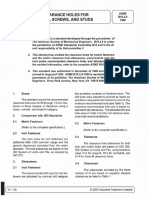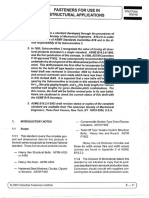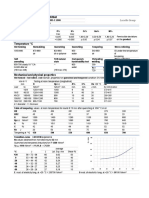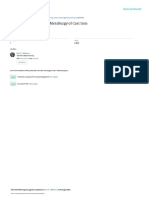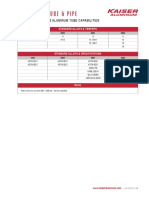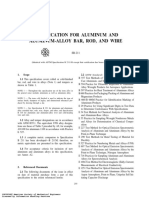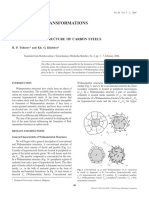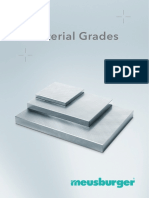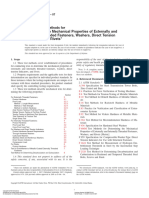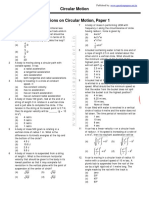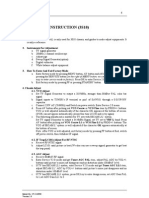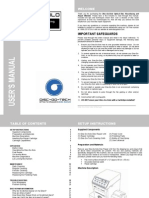ASTM F606 - 05 Fastener Test Methods
ASTM F606 - 05 Fastener Test Methods
Uploaded by
Fernado RinconCopyright:
Available Formats
ASTM F606 - 05 Fastener Test Methods
ASTM F606 - 05 Fastener Test Methods
Uploaded by
Fernado RinconOriginal Title
Copyright
Available Formats
Share this document
Did you find this document useful?
Is this content inappropriate?
Copyright:
Available Formats
ASTM F606 - 05 Fastener Test Methods
ASTM F606 - 05 Fastener Test Methods
Uploaded by
Fernado RinconCopyright:
Available Formats
Designation: F 606 – 05
Standard Test Methods for
Determining the Mechanical Properties of Externally and
Internally Threaded Fasteners, Washers, and Rivets1
This standard is issued under the fixed designation F 606; the number immediately following the designation indicates the year of
original adoption or, in the case of revision, the year of last revision. A number in parentheses indicates the year of last reapproval. A
superscript epsilon (e) indicates an editorial change since the last revision or reapproval.
This standard has been approved for use by agencies of the Department of Defense.
1. Scope been developed—F 606M; therefore, no metric equivalents are shown in
these test methods.
1.1 These test methods cover establishment of procedures
for conducting tests to determine the mechanical properties of 2. Referenced Documents
externally and internally threaded fasteners, washers, and 2.1 ASTM Standards: 2
rivets. A 394 Specification for Steel Transmission Tower Bolts,
1.2 Property requirements and the applicable tests for their Zinc-Coated and Bare
determination are specified in individual product standards. In E 4 Practices for Force Verification of Testing Machines
those instances where the testing requirements are unique or at E 8 Test Methods for Tension Testing of Metallic Materials
variance with these standard procedures, the product standard E 10 Test Method for Brinell Hardness of Metallic Materi-
shall specify the controlling testing requirements. als
1.3 These test methods describe mechanical tests for deter- E 18 Test Methods for Rockwell Hardness and Rockwell
mining the following properties: Superficial Hardness of Metallic Materials
Section
For Externally Threaded Fasteners: 3
E 83 Practice for Verification and Classification of Exten-
Product Hardness 3.1 someter System
Proof Load 3.2.1 E 92 Test Method for Vickers Hardness of Metallic Mate-
Method 1, Length Measurement 3.2.3
Method 2, Yield Strength 3.2.4
rials
Method 3, Uniform Hardness 3.2.5 E 384 Test Method for Microindentation Hardness of Ma-
Axial Tension Testing of Full-Size Product 3.4 terials
Wedge Tension Testing of Full-Size Product 3.5
Tension Testing of Machined Test Specimens 3.6
F 436 Specification for Hardened Steel Washers
Total Extension at Fracture Test 3.7 F 606M Test Methods for Determining the Mechanical
Single Sheer Test 3.8 Properties of Externally and Internally Threaded Fasteners,
For Internally Threaded Fasteners: 4
Product Hardness 4.1
Washers, and Rivets [Metric]
Proof Load Test 4.2 F 959 Specification for Compressible-Washer-Type Direct
Cone Proof Load Test 4.3 Tension Indicators for Use With Structural Fasteners
For Washers and Direct Tension Indicators: 5
General Requirements 5.1
F 1624 Test Method for Measurement of Hydrogen Em-
Through Hardened Washers 5.2 brittlement Threshold in Steel by the Incremental Step
Carburized Washers 5.3 Loading Technique
For Rivets: 6
Product Hardness 6.1
2.2 Military Standard:3
Test for Embrittlement of Metallic-Coated Externally Threaded 7 MIL STD 1312, Test 13 and Test 20
Fasteners
3. Test Methods for Externally Threaded Fasteners
1.4 This standard does not purport to address all of the
safety concerns, if any, associated with its use. It is the 3.1 Product Hardness—Tests shall be conducted after the
responsibility of the user of this standard to establish appro- removal of any surface oxide, decarburization, plating or other
priate safety and health practices and determine the applica- coating. All readings shall be within the hardness values listed
bility of regulatory limitations prior to use. in the product specification. The average of all readings on the
NOTE 1—A complete metric companion to Test Methods F 606 has
2
For referenced ASTM standards, visit the ASTM website, www.astm.org, or
contact ASTM Customer Service at service@astm.org. For Annual Book of ASTM
1
These test methods are under the jurisdiction of ASTM Committee F16 on Standards volume information, refer to the standard’s Document Summary page on
Fasteners and are the direct responsibility of Subcommittee F16.01 on Test Methods. the ASTM website.
3
Current edition approved July 1, 2005. Published July 2005. Originally approved Available from Standardization Documents Order Desk, Bldg. 4 Section D, 700
in 1979. Last previous edition approved in 2002 as F 606 – 02e1. Robbins Ave., Philadelphia, PA 19111-5094, Attn: NPODS.
Copyright © ASTM International, 100 Barr Harbor Drive, PO Box C700, West Conshohocken, PA 19428-2959, United States.
--`,,,,,`,,,`,`,`,,`,,`,,,````,,,``,``,,,,`,,,,,,,``,-`-`,,`,,`,`,,`---
Copyright ASTM International 1
Copyright by ASTM Int'l (all rights reserved);
Provided by IHS under license with ASTM Sold to:API Ind, 345526
No reproduction or networking permitted without license from IHS Not for Resale,04/13/2006 10:17:51 MDT
Reproduction authorized per License Agreement with Kathe Hooper (ASTMIHS Account); Mon Aug 8 13:21:19 EDT 2005
F 606 – 05
same part shall be considered as the product hardness. Test 3.2 Tension Tests—It is preferred that bolts and studs be
results shall conform to the product specification for the lot tested full size, and it is customary, when so testing, to specify
represented by the test specimens to be considered conforming. a minimum ultimate load (or stress) in pounds-force (or
Test specimen preparation and hardness tests shall be con- pounds-force per square inch.) Sections 3.2-3.5 apply when
ducted in accordance with Test Methods E 18 for Rockwell testing externally threaded fasteners full size. Section 3.6 shall
tests, Test Method E 10 for Brinell tests, Test Method E 92 for apply where the individual product specifications permit the
Vickers tests, or Test Method E 384 for Microhardness tests. use of machined specimens (see Test Methods E 8).
The method used is at the option of the manufacturer, with 3.2.1 Proof Load—The proof-load test consists of stressing
regards to the size and grade of the products. the product with a specified load that the product must
3.1.1 Routine Test Locations—For testing the hardness of withstand without measurable permanent set. Alternative tests
the finished product, the following test locations can be used: for determining the ability of a fastener to pass the proof-load
3.1.1.1 For hex and square head bolts; test shall be con- test are the yield strength test and the uniform hardness test.
ducted on the wrench flats, top of head, unthreaded shank, end Either Method 1 (3.2.3), Method 2 (3.2.4), or Method 3 (3.2.5)
of bolt or at the arbitration location. may be used, but Method 1 shall be the arbitration method in
3.1.1.2 For studs, products without parallel wrench flats and case of any dispute as to acceptance of the product (see Test
for head styles other than hex and square; tests shall be Methods E 8).
conducted on the unthreaded shank, end of the bolt or stud or 3.2.2 In both Methods 1 and 2, assemble the product in the
at the arbitration location. fixture of the tension testing machine so that six complete
3.1.1.3 Stress relieved products (3.1.1.1 and 3.1.1.2) are threads (except for heavy hex structural bolts, which shall be
measured anywhere on the surface or through the cross section. based on four threads) are exposed between the grips. This is
Refer to the product specification for particular test location or obtained by freely running the nut or fixture to the thread
use the arbitration location. runout of the specimen and then unscrewing the specimen six
3.1.1.4 The Rockwell Hardness Scale may be used for all full turns. For continuous thread bolts, at least six full threads
product diameters; however, the Brinell hardness is limited to shall be exposed between the fixture ends; however, for referee
products over 11⁄2-in. nominal diameter. purposes, six full threads shall be exposed.
3.1.2 Laboratory Inspection—After observing 3.1 and 3.2.3 Method 1, Length Measurement—To ensure consistent
3.1.1, a minimum of three readings shall be taken on each and repetitive length measurements of the fastener, the
sample of finished product. threaded end and top of the bolt head shall have conical
3.1.3 Arbitration Test Location—For purposes of arbitration depressions made at the approximate axis or center line of the
between the purchaser and seller over reported test results, fastener. If raised or depressed markings on the head interfere
hardness tests shall be conducted at the mid-radius (r/2) of a with the placement of the measuring depressions, the head
transverse section through the threads taken at a distance of shall be carefully ground. The measuring instrument shall have
approximately one diameter from the point end of the bolt or pointed anvils which mate with the center line depressions and
one end of the stud. Four readings shall be taken from the point be capable of measuring changes in length of 0.0001 in. with
end of the bolt or one end of the stud. Four readings shall be an accuracy of 0.0001 in. in any 0.001 in. range. Place the
taken approximately 90° to one another on the same plane, if fastener between the measuring anvils and rotate it approxi-
product size permits. Smaller diameter products may also use mately 1⁄4 turn to the left center, right then center again to
the opposite parallel surface area of the bolt head end as assure sound seating. Zero the instrument or record indicated
sectioned above (see Fig. 1). The use of Brinell hardness is measurement. If using a bolt extensometer, the bolt with
limited to product sizes greater than 21⁄4-in. nominal diameter. attached extensometer may be assembled into the tension
FIG. 1 Hardness Arbitration Test Location
--`,,,,,`,,,`,`,`,,`,,`,,,````,,,``,``,,,,`,,,,,,,``,-`-`,,`,,`,`,,`---
Copyright ASTM International 2
Copyright by ASTM Int'l (all rights reserved);
Provided by IHS under license with ASTM Sold to:API Ind, 345526
No reproduction or networking permitted without license from IHS Not for Resale,04/13/2006 10:17:51 MDT
Reproduction authorized per License Agreement with Kathe Hooper (ASTMIHS Account); Mon Aug 8 13:21:19 EDT 2005
F 606 – 05
testing machine. If not, mark the fastener so it may be placed the bolt between the holders as shown in Fig. 2, which will be
as close as possible to the same position for the second reading. subject to elongation under load by using the method described
Remove and assemble the fastener into the tension testing in 3.6.3.1.
machine as outlined in 3.4. With a test speed which shall not 3.2.5 Method 3, Uniform Hardness—The fasteners shall be
exceed 0.12 in./min, as determined with a free-running cross tested for hardness as described in 3.1, and in addition, the
head, axially load the fastener to the proof load value specified hardness shall also be determined in the core. The difference
in the product specification. This load shall be maintained for between the mid-radius and core hardness shall be not more
a period of 10 s before releasing the load. Replace the fastener than 3 points on a Rockwell C Scale; and both readings must
between the measuring anvils and rotate as before, stopping the be within product specification. This test is valid for fasteners
mark at the same approximate position as the first reading. The up to and including 1 in. in diameter.
measurement shall show no permanent elongation. A tolerance 3.3 Bolts or Studs Too Short for Tension Testing—Product
of 60.0005 in. shall be allowed (for measurement error only) lengths less than those shown in Table 1 for product 1⁄4 through
3⁄4 in. in diameter and less than three diameters in length for
between the measurement made before loading and that made
after loading. Variables such as straightness, thread alignment, product above 3⁄4 in. in diameter, or that do not have sufficient
or measurement error could result in apparent elongation of the threads for proper engagement and still leave the specified
product when the specified proof load is initially applied. In number of complete threads exposed between the grips, shall
such cases, the product may be retested using a 3 % greater be deemed too short for tension testing, and acceptance shall be
load, and shall be considered acceptable if there is no differ- based on a hardness test performed in accordance with 3.1. If
tests other than product hardness are required, their require-
ence in the length measurement after this loading within a
ments should be referenced in the product specification.
0.0005 in. measurement tolerance as outlined.
3.4 Axial Tension Testing of Full-Size Products:
3.2.4 Method 2, Yield Strength—Assemble the product in
3.4.1 Test bolts in a holder with the load axially applied
the testing equipment as outlined in 3.4. As the load is applied,
between the head and a nut or suitable fixture (Fig. 2), either of
measure and record the total elongation of the product or any which shall have sufficient thread engagement to develop the
part of it that includes the exposed threads to produce a full strength of the product. Assemble the nut or fixture on the
load-elongation diagram. Determine the load or stress at an product, leaving a minimum of six complete bolt threads
offset equal to 0.2 % of the length of bolt occupied by six full exposed between the grips except for heavy hex structural
threads as shown in Fig. 2 (except for heavy hex structural bolts, which shall have four complete threads exposed between
--`,,,,,`,,,`,`,`,,`,,`,,,````,,,``,``,,,,`,,,,,,,``,-`-`,,`,,`,`,,`---
bolts, which shall be based on four threads) by the method the grips.
described in 3.6.3.1. 3.4.2 Test studs by assembling one end in the threaded
3.2.4.1 Method 2A, Yield Strength for Austenitic Stainless fixture to the thread runout. For studs having unlike threads,
Steel and Non-ferrous Materials—Assemble the product in the this shall be the end with the finer pitch thread, or with the
testing equipment as outlined in 3.4. As the load is applied, larger minor diameter. Likewise, assemble the other end of the
measure and record the total elongation of the product in order stud in a threaded fixture, leaving six complete threads exposed
to produce a load elongation diagram. Determine the load or between the grips. For continuous thread studs, at least six
stress at an offset equal to 0.2 % strain based on the length of complete threads shall be exposed between the fixture ends.
FIG. 2 Tension Testing of Full-Size Bolt (Typical Set-Up)
Copyright ASTM International 3
Provided by IHS under license with ASTM Copyright by ASTM Int'l (all rights reserved); Sold to:API Ind, 345526
No reproduction or networking permitted without license from IHS Not for Resale,04/13/2006 10:17:51 MDT
Reproduction authorized per License Agreement with Kathe Hooper (ASTMIHS Account); Mon Aug 8 13:21:19 EDT 2005
--`,,,,,`,,,`,`,`,,`,,`,,,````,,,``,``,,,,`,,,,,,,``,-`-`,,`,,`,`,,`---
F 606 – 05
TABLE 1 Minimum Length of Product Requiring Tension Testing any load, including those above the minimum requirements.
Nominal Product Size, in. Minimum Length, in.
3.5.2 Wedge Tension Testing of Studs—When both wedge
⁄
14 ⁄
58
tension and proof load testing are required by the product
⁄
5 16 ⁄
34 specifications, assemble one end of the same stud previously
3⁄8 7 ⁄8
used for proof load testing in a threaded fixture to the thread
7⁄16 1
1⁄ 2 1 1⁄ 8
runout. For studs having unlike threads, this shall be the end
9⁄16 1 1⁄ 4 with the finer pitch thread or with the larger minor diameter.
5⁄8 1 1⁄ 2 Assemble the other end of the stud in a threaded wedge to the
3⁄4 1 3⁄ 4
7⁄8 and larger 3 dia
runout and then unscrew six full turns, thus leaving six
complete threads exposed between the grips, as illustrated in
Fig. 4. For continuous thread studs, at least six complete
The maximum speed of the free-running cross head shall not threads shall be exposed between the fixture ends. The angle of
exceed 1 in./min. When reporting the tensile strength of the wedge for the stud size and grade shall be as specified in
product, in pounds-force per square inch, calculate the thread Table 2. Assemble the stud in the testing machine and tension
stress area as follows: test to fracture, as described in 3.4. The minimum hardness of
the threaded wedge shall be 45 HRC. The length of the
As 5 0.7854 [D 2 ~0.9743!/n#2 (1) threaded section of the wedge shall be equal to at least the
where: diameter of the stud. To facilitate removal of the broken stud,
As = thread stress area, in.2, counterbore the wedge. The thickness of the wedge at the thin
D = nominal diameter of bolt or stud, in., and side of the hole shall equal the diameter of the stud plus the
n = number of threads per inch. depth of counterbore. The thread in the wedge shall have Class
3.4.3 To meet the requirements of the test described in 3.4.1 3B tolerances, except when testing studs having an interference
and 3.4.2, the product shall support a load prior to fracture not fit thread, in which case the wedge shall be threaded to provide
less than the minimum tensile strength specified in the product a finger-free fit. The supporting fixture, as shown in Fig. 4,
specification for its size, strength, and thread series. In addi- shall have a hole clearance over the nominal size of the stud,
tion, the tensile fracture shall occur in the body or threaded and shall have its top and bottom edges rounded or chamfered
section with no fracture at the junction of head and shank. to the same limits specified for the hardened wedge in Table 3.
3.5 Wedge Tension Testing of Full-Size Product—The To meet the requirements of this test, the stud shall support a
wedge tensile strength of a hex or square-head fastener, load prior to fracture not less than the minimum tensile strength
socket-head cap screw (with the exception of socket button or specified in the product specification for its size, grade, and
flat countersunk head products) or stud is the tensile load that thread series.
the product is capable of sustaining when stressed with a NOTE 3—Dimensional tolerances for all test fixtures used in this test
wedge under the head. The purpose of this test is to obtain the method, unless otherwise noted, shall conform to standard machining
tensile strength and demonstrate the “head quality” and duc- practices.
tility of the product. 3.6 Tension Testing of Machined Test Specimens:
3.5.1 Wedge Tension Testing of Bolts—Determine the ulti- 3.6.1 Where bolts and studs cannot be tested full size,
mate load of the bolt as described in 3.4 except place a wedge conduct tests using test specimens machined from the bolt or
under the bolt head. When both wedge tension and proof load stud (see Test Methods E 8).
testing are required by the product specification use the proof 3.6.1.1 Bolts and studs 9⁄16 in. in diameter and smaller may
load-tested bolts for wedge testing. The wedge shall have a be machined concentric with the axis of the bolt or stud. The
minimum hardness of 45 HRC. Additionally, the wedge shall specimen shall have a turned section as large as feasible and
have a minimum thickness of one half the nominal bolt shall have a gage length four times the diameter of the
diameter (measured at the thin side of the hole, see Fig. 3). The specimen. See Fig. 5 and Fig. 6.
wedge shall have an included angle as shown in Table 2 for the 3.6.1.2 Bolts and studs 5⁄8 in. in diameter through 11⁄4 in. in
product type being tested. The hole in the wedge shall have a diameter may have their shanks machined concentric with the
clearance over the nominal size of the bolt, and its edges top axis of the bolt or stud, leaving the bolt head and threaded
and bottom shall be rounded as specified in Table 3. The section intact as shown in Fig. 5. Alternatively, bolts and studs
minimum outside dimension of the wedge shall be such that 5⁄8 in. in diameter through 11⁄4 in. in diameter may have their
during the test no corner loading of the product head (adjacent shanks machined to a test specimen with the axis of the
to the wedge) shall occur (see head orientation in Fig. 3). The specimen located midway between the axis and outside surface
bolt shall be tension tested to fracture. To meet the require- of the bolt or stud as shown in Fig. 7. Bolts of a small cross
ments of this test, the bolt shall support a load prior to fracture section that will not permit taking the 0.500-in. round, 2-in.
not less than the minimum tensile strength specified in the gage length test specimen shall have a turned section as large
product specification for the applicable size, grade, and thread as feasible and concentric with the axis of the bolt or stud. The
series. In addition, the tensile fracture shall occur in the body gage length for measuring the elongation shall be four times
or threaded section with no fracture at the junction of head and the diameter of the specimen. Fig. 6 illustrates an example of
shank. these small-size specimens. For arbitration purposes, machined
NOTE 2—Fracture at the junction of the head and shank is prohibited at test specimens for bolts and studs 5⁄8 in. in diameter through
Copyright ASTM International 4
Provided by IHS under license with ASTM Copyright by ASTM Int'l (all rights reserved); Sold to:API Ind, 345526
No reproduction or networking permitted without license from IHS Not for Resale,04/13/2006 10:17:51 MDT
Reproduction authorized per License Agreement with Kathe Hooper (ASTMIHS Account); Mon Aug 8 13:21:19 EDT 2005
F 606 – 05
c = clearance of hole
D = diameter of bolt or screw
R = radius or chamfer
T = reference thickness of wedge at thin side of hole equals one half diameter of bolt or
screw
W = wedge angle (see Table 2)
FIG. 3 Wedge Test Details—Bolts
TABLE 2 Tension Test Wedge Angles TABLE 3 Tensile Test Wedge Hole Clearance—Details
Nominal Product Size, in. Degrees Nominal Product Nominal Clearance in Nominal Radius on
Size, in. Hole, in. Corners of Hole, in.
BoltsA Studs and
Flange Bolts 14⁄ – ⁄
12 0.030 0.030
⁄
9 16 – ⁄
34 0.050 0.060
⁄ –1
14 10 6 7⁄ 8 – 1 0.060 0.060
Over 1 6 4
1 1⁄ 8 – 1 1⁄ 4 0.060 0.125
A
Heat-treated bolts that are threaded one diameter or closer to the underside of 1 3⁄ 8 – 1 1⁄ 2 0.094 0.125
the head, shall use a wedge angle of 6° for sizes 1⁄4 through 3⁄4 in. and 4° for sizes 1 3⁄ 4 – 2 0.094 0.225
over 3⁄4 in. 2 1⁄ 4 – 3 0.125 0.256
11⁄4 in. in diameter shall be machined with the axis of the
specimen located midway between the center and outside 3.6.1.4 Machined test specimens shall exhibit tensile
surface. strength, yield strength (or yield point), elongation, and reduc-
3.6.1.3 Bolts and studs 13⁄8 in. in diameter and larger may tion of area equal to or greater than the values of these
have their shanks machined to the dimensions of a 0.500-in. properties specified for the product size in the applicable
round, 2-in. gage length test specimen with the axis of the product specification when tested in accordance with this
specimen located midway between the center and outside section.
surface of the bolt or stud as shown in Fig. 7. 3.6.2 Determination of Tensile Properties:
--`,,,,,`,,,`,`,`,,`,,`,,,````,,,``,``,,,,`,,,,,,,``,-`-`,,`,,`,`,,`---
Copyright ASTM International 5
Copyright by ASTM Int'l (all rights reserved);
Provided by IHS under license with ASTM Sold to:API Ind, 345526
No reproduction or networking permitted without license from IHS Not for Resale,04/13/2006 10:17:51 MDT
Reproduction authorized per License Agreement with Kathe Hooper (ASTMIHS Account); Mon Aug 8 13:21:19 EDT 2005
F 606 – 05
FIG. 4 Wedge Test Details—Studs
--`,,,,,`,,,`,`,`,,`,,`,,,````,,,``,``,,,,`,,,,,,,``,-`-`,,`,,`,`,,`---
FIG. 5 Tension Test Specimen for Bolt with Turned-Down Shank
FIG. 7 Location of Standard Round 2-in. Gage Length Tension
Test Specimen When Turned from Large Size Bolt
FIG. 6 Examples of Small-Size Specimens Proportional to the balance position, and the beam of the machine will drop for
Standard 2-in. Gage Length Specimen a brief but appreciable interval of time. When a machine
equipped with a load-indicating dial is used, there is a halt or
hesitation of the load-indicating pointer corresponding to the
3.6.2.1 Yield Point—Yield point is the first stress in a drop of the beam. Note the load at the “drop of the beam” or
material, less than the maximum obtainable stress, at which an the “halt of the pointer” and record the corresponding stress as
increase in strain occurs without an increase in stress. Yield the yield point.
point is intended for application only for materials that may 3.6.2.3 Autographic Diagram Method—When a sharp-
exhibit the unique characteristic of showing an increase in kneed stress-strain diagram is obtained by an autographic
strain without an increase in stress. The stress-strain diagram is recording device, take the stress corresponding to the top of the
characterized by a sharp knee or discontinuity. Determine yield knee (Fig. 8), or the stress at which the curve drops as the yield
point by one of the following methods: point (Fig. 9).
3.6.2.2 Drop of the Beam or Halt of the Pointer Method—In 3.6.2.4 Total Extension Under Load Method—When testing
this method apply an increasing load to the specimen at a material for yield point and the test specimens may not exhibit
uniform rate. When a lever and poise machine is used, keep the a well-defined disproportionate deformation that characterizes
beam in balance by running out the poise at approximately a a yield point as measured by the drop of the beam, halt of the
steady rate. When the yield point of the material is reached, the pointer, or autographic diagram methods described in 3.6.2.2
increase of the load will stop, but run the poise a trifle beyond and 3.6.2.3, a value equivalent to the yield point in its practical
Copyright ASTM International 6
Copyright by ASTM Int'l (all rights reserved);
Provided by IHS under license with ASTM Sold to:API Ind, 345526
No reproduction or networking permitted without license from IHS Not for Resale,04/13/2006 10:17:51 MDT
Reproduction authorized per License Agreement with Kathe Hooper (ASTMIHS Account); Mon Aug 8 13:21:19 EDT 2005
F 606 – 05
FIG. 10 Stress-Strain Diagram Showing Yield Point or Yield
Strength by Extension Under Load Method
NOTE 6—For steel with a specified yield point not over 80 000 psi, an
appropriate value is 0.005 in./in. of gage length. For values above 80 000
FIG. 8 Stress-Strain Diagram for Determination of Yield psi, this test method is not valid unless the limiting total extension is
Strength by the Offset Method increased.
3.6.3 Yield Strength—Yield strength is the stress at which a
material exhibits a specified limiting deviation from the pro-
portionality of stress to strain. The deviation is expressed in
terms of strain, percent offset, total extension under load, etc.
Determine yield strength by one of the following methods:
3.6.3.1 Offset Method—To determine the yield strength by
the “offset method,” it is necessary to secure data (autographic
or numerical) from which a stress-strain diagram may be
drawn. Then on the stress-strain diagram (Fig. 8) lay off Om
equal to the specified value of the offset, draw mn parallel to
OA, and thus locate r. The yield strength load R is the load
corresponding to the highest point of the stress-strain curve
before or at the intersection of mn with r. In reporting values of
yield strength obtained by this method, the specified value of
“offset” used should be stated in parentheses after the term
yield strength, thus:
Yield strength ~0.2 % offset! 5 52 000 psi (2)
--`,,,,,`,,,`,`,`,,`,,`,,,````,,,``,``,,,,`,,,,,,,``,-`-`,,`,,`,`,,`---
In using this method, a minimum extensometer magnification
FIG. 9 Stress-Strain Diagram Showing Yield Point of 250 to 1 is required. A Class B1 extensometer meets this
Corresponding with Top of Knee requirement (see Note 5). See also Note 7 for automatic
devices.
3.6.3.2 Extension Under Load Method—For tests to deter-
significance may be determined by the following method and
mine the acceptance or rejection of material whose stress-strain
may be recorded as yield point: Attach a Class C or better
characteristics are well known from previous tests of similar
extensometer (Note 4 and Note 5) to the specimen. When the
material in which stress-strain diagrams were plotted, the total
load producing a specified extension (Note 6) is reached,
strain corresponding to the stress at which the specified offset
record the stress corresponding to the load as the yield point,
(see Note 8) occurs will be known within satisfactory limits.
and remove the extensometer (Fig. 10).
The stress on the specimen, when this total strain is reached, is
NOTE 4—Automatic devices are available that determine the load at the the value of the yield strength. The total strain can be obtained
specified total extension without plotting a stress-strain curve. Such de satisfactorily by use of a Class B1 extensometer (Note 4 and
vices may be used if their accuracy has been demonstrated. Multiplying Note 5).
calipers and other such devices are acceptable for use provided their
accuracy has been demonstrated as equivalent to a Class C extensometer. NOTE 7—Automatic devices are available that determine offset yield
NOTE 5—Reference should be made to Practice E 83. strength without plotting a stress strain curve. Such devices may be used
Copyright ASTM International 7
Copyright by ASTM Int'l (all rights reserved);
Provided by IHS under license with ASTM Sold to:API Ind, 345526
No reproduction or networking permitted without license from IHS Not for Resale,04/13/2006 10:17:51 MDT
Reproduction authorized per License Agreement with Kathe Hooper (ASTMIHS Account); Mon Aug 8 13:21:19 EDT 2005
F 606 – 05
if their accuracy has been demonstrated.
NOTE 8—The appropriate magnitude of the extension under load will
obviously vary with the strength range of the particular material under
test. In general, the value of extension under load applicable to any
material strength level may be determined from the sum of the propor-
tional strain and the plastic strain expected at the specified yield strength.
The following equation is used:
Extension under load, in./in. of gage length = (YS/E) = r
where:
YS = specified yield strength, psi,
E = modulus of elasticity, psi, and
r = limiting plastic strain, in./in.
3.6.4 Tensile Strength—Calculate the tensile strength by
dividing the maximum load the specimen sustains during a FIG. 11 Determination of Total Extension at Fracture (AL)
tension test by the original cross-sectional area of the speci- (only Screw Product Shown)
men.
3.6.5 Elongation:
3.6.5.1 Fit the ends of the fractured specimen together Fig. 11). The total extension at fracture shall then be calculated
carefully and measure the distance between the gage marks to as follows:
the nearest 0.01 in. for gage lengths of 2 in. and under, and to AL= L2− L1
the nearest 0.5 % of the gage length for gage lengths over 2 in. 3.7.5 The value obtained shall equal or exceed the minimum
A percentage scale reading to 0.5 % of the gage length may be values shown in the applicable specification for the product and
used. The elongation is the increase in length of the gage material type.
length, expressed as a percentage of the original gage length. In 3.8 Single Shear Test—(Note 9) This test is intended to
reporting elongation values, give both the percentage increase determine the ability of a fastener to withstand a predetermined
and the original gage length. load when applied transversely to the axis of the fastener. Shear
3.6.5.2 If any part of the fracture takes place outside of the is defined as an action or stress caused by applied forces that
--`,,,,,`,,,`,`,`,,`,,`,,,````,,,``,``,,,,`,,,,,,,``,-`-`,,`,,`,`,,`---
middle half of the gage length or in a punched or scribed mark causes two adjacent parts of a body to slide on each other to
within the reduced section, the elongation value obtained may cause separation. Shear tests may be conducted in either
not be representative of the material. If the elongation so tension-type or compression-type single shear fixture.
measured meets the minimum requirements specified, no 3.8.1 The specimen shall be tested using hardened steel
further testing is indicated, but if the elongation is less than the plates of sufficient thickness to preclude bearing failure. Holes
minimum requirements, discard the test and retest. in the shear plates shall be 1⁄16 in. larger than the nominal thread
3.6.6 Reduction of Area—Fit the ends of the fractured diameter of the test bolt and the holes shall be chamfered 0.010
specimen together and measure the mean diameter or the width in. to relieve sharp edges. Shear plates shall be prevented from
and thickness at the smallest cross section to the same accuracy separating by means of a suitable jig or by using a nut on the
as the original dimensions. The difference between the area test bolt tightened finger tight.
thus found and the area of the original cross section expressed 3.8.2 The test specimen, when assembled in the shear jig,
as a percentage of the original area, is the reduction of area. shall be mounted in a tensile-testing machine capable of
3.7 Total Extension at Fracture Test: applying load at a controllable rate. The grips shall be
3.7.1 The extension at fracture (AL) test shall be carried out self-aligning and care shall be taken when mounting the
on stainless steel and nonferrous products (bolts, screws, and specimen to assure that the load will be transmitted in a straight
studs) in the finished condition, with lengths equal to or in line transversely through the test bolt. Load shall be applied
excess of those minimums listed in Table 1. and continued until fracture of the bolt. Speed of testing as
3.7.2 The products to be tested shall be measured for total determined with a free-running cross head shall not be less than
length (L1) as described in 3.7.2.1 and shown in Fig. 11. 1⁄4 in. nor greater than 1⁄2 in. per min.
3.7.2.1 Mark both ends of the bolt, screw, or stud using a 3.8.3 The maximum load applied to the specimen, coinci-
permanent marking substance such as bluing so that measuring dent with or prior to bolt fracture shall be recorded as the shear
reference points for determining total length L1 and L2 are strength of the bolt. At the discretion of the testing activity,
established. Using an open-end caliper and steel rule or other tests need not be continued to destruction provided that the
device capable of measuring to within 0.010 in., determine the specimen supports, without evidence of bolt fracture, the
total length of the product as shown in Fig. 11. minimum load specified.
3.7.3 The product under test shall be screwed into the 3.8.4 A typical test fixture for tension shear testing is shown
threaded adapter to a depth of one diameter (see Fig. 2) and in Fig. 12.
load applied axially until the product fractures. The maximum
NOTE 9—This single-shear test is primarily used for testing Specifica-
speed of the free-running cross head shall not exceed 1 in./min.
tion A 394 tower bolts which range in size from 1⁄2 through 1 in. diameter.
3.7.4 After the product has been fractured in accordance For general use, the shear test practices and fixturing found in MIL STD
with 3.7.3, the two broken pieces shall be fitted closely 1312 Test 13 is used for double shear and Test 20 may be used for single
together and the overall length (L2) measured (see 3.7.2.1 and shear.
Copyright ASTM International 8
Provided by IHS under license with ASTM Copyright by ASTM Int'l (all rights reserved); Sold to:API Ind, 345526
No reproduction or networking permitted without license from IHS Not for Resale,04/13/2006 10:17:51 MDT
Reproduction authorized per License Agreement with Kathe Hooper (ASTMIHS Account); Mon Aug 8 13:21:19 EDT 2005
F 606 – 05
FIG. 13 Nonheat-Treated Nut
4.1.3.3 Heat-Treated Nuts (See Fig. 14)—Two sets of three
readings 180° apart shall be taken. The three readings shall be
taken across the section of the nut at the following positions:
Open Jig Test Bolt Assembled Position 1—As close to the major diameter, as possible, if threaded, or
FIG. 12 Typical Single Shear Fixture (Tension Type) hole side wall if the nut is blank, but no closer than 21⁄2 times the indent
diameter.
Position 2—At the core (halfway between the major diameter, if
4. Test Methods for Internally Threaded Fasteners threaded, or hole side wall, if blank) and a corner of the nut.
Position 3—As close to the corner of the nut as possible, but no closer
4.1 Product Hardness—For routine inspection of both heat- than 21⁄2 times the indent diameter.
treated and nonheat-treated nuts, hardness shall be determined
on the bearing face or wrench flats after removal of any oxide, 4.1.3.4 The reported hardness shall be the average of all six
decarburization, plating, or other coating material. Rockwell or readings. In addition all readings shall be within hardness
--`,,,,,`,,,`,`,`,,`,,`,,,````,,,``,``,,,,`,,,,,,,``,-`-`,,`,,`,`,,`---
Brinell hardness shall be used at the option of the manufac- values listed in the product specification.
turer, taking into account the size and grade of the product. 4.1.4 Nuts exhibiting a proofload in excess of 160 000 lb
4.1.1 The preparation of test specimens and the perfor- may be considered, at the option of the manufacturer, as too
mance of hardness tests for Rockwell and Brinell testing shall large for full-size testing. Full-size testing is recommended
be in conformance with the requirements of Test Methods E 18 whenever possible.
and E 10, respectively. 4.1.5 For nuts on which hardness and proof load tests are
4.1.2 Readings when taken on the bearing face shall be performed, acceptance based on proof load requirements shall
halfway between the major diameter of the thread and one take precedence in the event of controversy with hardness tests.
corner. The reported hardness shall be the average of two 4.2 Proof Load Test—Assemble the nut to be tested on a
hardness readings located 180° apart. The readings when taken hardened threaded mandrel (4.2.2) or a test bolt (4.2.1) as
on the wrench flats shall be one third of the distance from a illustrated in Fig. 15(a) Tension Method or Fig. 15(b) Com-
corner to the center of the wrench face. The reported harness pression Method. The hardened test mandrel and the tension
shall be the average of two readings located from opposite method shown in Fig. 15(a) shall be mandatory as a referee if
corners. arbitration is necessary. Apply the specified proof load for the
4.1.3 For the purpose of arbitration or for nuts too large for nut against the nut. The nut shall resist this load without
full size testing, where hardness alone shall determine accep- stripping or rupture, and shall be removable from the test bolt
tance (see 4.1.4), the following shall apply. or mandrel by the fingers after the load is released. Occasion-
4.1.3.1 Sample nuts shall be sectioned laterally at approxi- ally it may be necessary to use a manual wrench or other means
mately one half (1⁄2) of the nut height. Such samples need not to start the nut in motion. Use of such means is permissible,
be threaded, but shall be part of the manufacturing lot that was provided the nut is removable by the fingers following the
formed (in the case of heat-treated nuts, formed and heat- initial loosening of not more than one-half turn of the nut. If the
treated) with the product to be shipped. The preparation of the threads of the mandrel or test bolt are damaged during the test,
sample shall be in accordance with 4.1.1 above. All readings discard the test.
shall be conducted on a Rockwell Hardness testing machine.
For standard hex, heavy hex and square nuts, the half of the nut
not to be tested may be discarded. For special nut configura-
tions both sections shall be identified and made available to the
purchaser, if specified on the purchase order or inquiry.
4.1.3.2 Nonheat-Treated Nuts (See Fig. 13)—Two readings
shall be taken 180° apart at the core (halfway between the
major diameter if threaded, or blank hole if not threaded) and
a corner of the nut. The reported hardness shall be the average
of the two readings, and in addition both readings shall be
within the hardness values listed in the product specification. FIG. 14 Heat-Treated Nut
Copyright ASTM International 9
Copyright by ASTM Int'l (all rights reserved);
Provided by IHS under license with ASTM Sold to:API Ind, 345526
No reproduction or networking permitted without license from IHS Not for Resale,04/13/2006 10:17:51 MDT
Reproduction authorized per License Agreement with Kathe Hooper (ASTMIHS Account); Mon Aug 8 13:21:19 EDT 2005
F 606 – 05
FIG. 15 Proof Load Testing—Nuts
4.2.1 The test bolt shall have threads appropriate to the eter plus 0.002 in. or 0.25 times the major diameter tolerance
standard specified for the nut being tested and shall have a (whichever is greater) of Class 3A threads.
yield strength in excess of the specified proof load of the nut 4.2.3 The proof load shall be determined at a free running
being tested. cross head speed not exceeding 1.0 in/minute and shall be held
4.2.2 Mandrels shall have a hardness of 45 HRC minimum at load for 10s minimum.
and shall have threads conforming to Class 3A except that the 4.3 Cone Proof Load Test—Perform this test using a conical
maximum major diameter shall be the minimum major diam- washer and threaded mandrel (as illustrated in Fig. 16) to
--`,,,,,`,,,`,`,`,,`,,`,,,````,,,``,``,,,,`,,,,,,,``,-`-`,,`,,`,`,,`---
FIG. 16 Cone-Proof Test
Copyright ASTM International 10
Provided by IHS under license with ASTM Copyright by ASTM Int'l (all rights reserved); Sold to:API Ind, 345526
No reproduction or networking permitted without license from IHS Not for Resale,04/13/2006 10:17:51 MDT
Reproduction authorized per License Agreement with Kathe Hooper (ASTMIHS Account); Mon Aug 8 13:21:19 EDT 2005
F 606 – 05
determine the influence of surface discontinuities (that is,
forging cracks and seams) on the load-carrying ability of
hardened steel nuts through 11⁄2 in. in diameter by introducing
a simultaneous dilation and stripping action of the nut. The
mandrel shall conform to the requirements of 4.2.2. The
conical washer shall have a hardness of 57 HRC minimum and
a hole diameter equivalent to the nominal diameter of the
mandrel +0.002, −0.000 in. The contact point of the cone shall
be sharp for nut sizes 1⁄2 in. and less. For sizes over 1⁄2 in., the
point shall be flat and 0.015 6 0.001 in. in width. Assemble the
nut and the conical washer on the mandrel, and apply the cone
proof load for the nut against the nut. The speed of testing as
determined with a free-running cross head shall be a maximum
of 0.12 in./min. Apply the proof load for 10 s. Compute the
cone proof load of a nut as follows:
CPL = (1 − 0.30D) 3 f 3 As
where:
CPL = cone proof load, lb, FIG. 17 Typical Hardness Reading Locations
D = nominal diameter of nut, in.,
f = specified proof stress of nut, psi,
As = tensile stress area of nut, in.2,
--`,,,,,`,,,`,`,`,,`,,`,,,````,,,``,``,,,,`,,,,,,,``,-`-`,,`,,`,`,,`---
5.3.1 Surface Hardness—Take hardness readings on a
= 0.7854 [D − (0.9743/n)]2, and smooth flat portion of the washer, using a method which
n = threads per inch. prevents penetration into the core material.
To meet the requirements of the cone proof load test, the nut 5.3.2 Core Hardness—Take hardness readings on a smooth
shall support its specified cone proof load without stripping or
flat portion of the washer, prepared by light grinding or
rupture.
polishing such that readings are taken at a depth greater than
the depth of case.
5. Test Methods for Washers and Direct Tension
Indicators 5.3.3 Depth of Case—Measurements of case depth shall be
taken at a cross section through the rim of the washer, having
5.1 General Requirements: been ground and etched to define the case area.
5.1.1 All tests shall be conducted on a Rockwell hardness
5.4 Stainless Steel and Nonferrous Washers:
tester.
5.1.2 Use of a 1⁄4 in. (6 mm) or smaller spot anvil shall be 5.4.1 Surface Hardness—Take hardness readings on a
used for hardness testing of washers and direct tension indica- smooth flat portion of the washer.
tors 5.4.2 Core Hardness—Take hardness readings on a smooth
5.1.3 Readings are not to be taken on or near product flat portion of the washer, prepared by light grinding or
markings. polishing such that readings are taken at a minimum depth of
5.1.4 Preparation of test specimens and the performance of 0.015 in. (0.38 mm) from the original surface.
hardness tests shall be performed in accordance with Test 5.5 Direct Tension Indicators:
Methods E 18. 5.5.1 Surface Hardness—Take hardness readings on a
5.1.5 For arbitration purposes, a minimum of two readings smooth flat portion of the DTI, at a point approximately
180° apart on at least one face shall be taken (see Fig. 17). midway between the protrusion (top side) or pocket (bottom
5.1.6 All readings shall be within the hardness values listed side) and the outside diameter. Prepare the DTI by light
in the product specification, and the average of all readings grinding or polishing as necessary.
shall be considered as the hardness of the product.
5.5.2 Core Hardness—Take hardness readings on a smooth
5.1.7 An initial reading may be used to establish that the
flat portion of the DTI, at a point approximately midway
hardness testing equipment is properly set up and that the
between the protrusion (top side) or pocket (bottom side) and
correct scale is being used. Such readings are not used to
the outside diameter. Prepare the DTI by light grinding or
determine conformance.
polishing such that readings are taken at a minimum depth of
5.2 Through Hardened Washers:
0.015 in. (0.38 mm) from the original surface.
5.2.1 Surface Hardness—Take hardness readings on a
smooth flat portion of the washer, prepared by light grinding or
6. Rivets
polishing as necessary.
5.2.2 Core Hardness—Take hardness readings on a smooth 6.1 Product Hardness—Determine hardness at the mid-
flat portion of the washer, prepared by light grinding or radius of a transverse section of the product taken at a distance
polishing such that readings are taken at a minimum depth of of one diameter from the point end of the rivet. Use either
0.015 in. (0.38 mm) from the original surface. Brinell or Rockwell hardness tests, and measure as described in
5.3 Carburized Washers: 3.1.
Copyright ASTM International 11
Provided by IHS under license with ASTM Copyright by ASTM Int'l (all rights reserved); Sold to:API Ind, 345526
No reproduction or networking permitted without license from IHS Not for Resale,04/13/2006 10:17:51 MDT
Reproduction authorized per License Agreement with Kathe Hooper (ASTMIHS Account); Mon Aug 8 13:21:19 EDT 2005
F 606 – 05
7. Test for Embrittlement of Metallic Coated Externally 7.2.4 If a direct tension method of tightening is used, then
Threaded Fasteners the loss of clamping strength (in pounds) over the test period
shall be no more than 10 % of the initial clamping load.
7.1 This is one test method for determining if embrittlement
exists in a metallic coated externally threaded fastener covered 7.3 The test fixture shall comprise a hardened wedge (7.3.1),
by the product specifications of ASTM Committee F16. a plate(s) (7.3.2), and a hardened washer (7.3.3) (see Fig. 18).
7.3.1 The wedge shall have an angle as specified in Table 4.
7.2 The test fastener shall be installed in a test fixture (see
Other dimensions and properties shall be in conformance with
Note 1 in Fig. 18) with the head positioned against the wedge,
hardened wedges described in 3.5.1.
assembled with a nut, and tensioned (by means of the nut only)
7.3.2 The plate(s) shall be steel and have a thickness such
by any means capable of measuring tensile load. The torque
that, after installation and tightening, a minimum of three full
method described in 7.3 is one such method. The test samples
threads of the test fastener will be in the grip. The hole in the
shall be tensioned to 75 % of their specified minimum ultimate
plate(s) shall be as close to the major diameter of the fastener
tensile strength. For studs with different thread pitches on
being tested as practical but not greater than the hole in the
either end, the finer thread pitch end shall be assembled with a
hardened washer (7.2.3).
nut and tested as the head end of the fastener.
7.3.3 The hardened washer shall be in conformance with
7.2.1 The assembly shall remain in this tightened state for Specification F 436.
not less than 48 h, after which the test fastener shall be visually
7.4 If the torque method of tightening is used, the tightening
examined for embrittlement-induced failure, such as missing
torque shall be determined using a load-measuring device
head. capable of measuring the actual tension induced in a fastener as
7.2.2 The joint shall then be disassembled and the test the fastener is tightened. Three fasteners from the test lot shall
fastener visually examined using a minimum of 20 power be selected at random. Each shall be assembled into the
magnification for evidence of embrittlement failure, such as load-measuring device, mated with a nut, and the nut tightened
transverse cracks in the shank, threads or at the junction of until a load equal to 75 % of the specified minimum ultimate
head to shank. tensile strength of the fastener is induced. The torque required
7.2.3 For disassembly, if the torque method of tightening is to induce this load shall be measured and the arithmetic
--`,,,,,`,,,`,`,`,,`,,`,,,````,,,``,``,,,,`,,,,,,,``,-`-`,,`,,`,`,,`---
used, torque shall be applied in the ON direction until the nut average of the three measured torques shall be the tightening
rotates a noticeable amount. The retightening torque with the torque. The surface against which the nut is torqued should be
nut in motion shall be measured and shall be no less than 90 % similar in hardness and finish to that of the test fixture (Fig. 18)
of the initial tightening torque. and use of a hardened washer (7.3.3) is recommended.
NOTE 1—For expedience sake the test fixture shown above reflects a single bolt under load. It should be noted, however, that test fixtures with multiple
test locations are acceptable
NOTE 2—Work is continuing on this test method and revisions are anticipated. Additionally caution should be taken when applying this test procedure.
The heads of embrittled fasteners may suddenly break off and become flying projectiles capable of causing serious injury or blinding.
FIG. 18 Test Fixture
Copyright ASTM International 12
Copyright by ASTM Int'l (all rights reserved);
Provided by IHS under license with ASTM Sold to:API Ind, 345526
No reproduction or networking permitted without license from IHS Not for Resale,04/13/2006 10:17:51 MDT
Reproduction authorized per License Agreement with Kathe Hooper (ASTMIHS Account); Mon Aug 8 13:21:19 EDT 2005
F 606 – 05
TABLE 4 Test for Embrittlement Wedge Angles, Degrees 8. Certification
Nominal Size of Studs and Fasteners Fasteners with
8.1 Certification shall include a statement that the sampled
Fastener, dia with Unthreaded Unthreaded Lengths, and provided fastener products were tested and inspected in
Lengths, 2 dia and Longer accordance with the requirements of the individual product
Less Than 2 dia
specification; referencing the specification number, year date of
1⁄4 to 3⁄4 in. 4 6
Over 3⁄4 to 1-1⁄2 in. 0 4
issue, and any applicable product identification symbols. In
addition, the certificate shall include the results of all tests
performed, the product specification, and any supplementary
requirements or other requirements as designated in the pur-
7.5 To meet the requirements of this test the fastener shall chase order.
show no evidence of embrittlement failure when visually 8.2 A certificate printed from or used in electronic form
examined and the retightening torque shall not be less than from an electronic data interchange (EDI) transmission shall be
90 % of the initial tightening torque. regarded as having the same validity as an original document
printed in the certifier’s facility. The content of the EDI
NOTE 10—The nature of this test method is such that a fastener will transmitted document shall also conform to any existing EDI
either pass or fail as a result of being subjected to the test conditions. The
qualitative nature of the test does not provide information on how close or
agreement between the purchaser and supplier.
--`,,,,,`,,,`,`,`,,`,,`,,,````,,,``,``,,,,`,,,,,,,``,-`-`,,`,,`,`,,`---
how far a fastener is from failure. This test method is to be used for 8.3 Notwithstanding the absence of a signature, the organi-
embrittlement testing on a production scale and is not to be used for zation submitting either the EDI transmission or paper copies
analytical purposes. Test Method F 1624 can be used as an analytical of certificates of test is responsible for the content of the report.
method to test fastener products in cases of uncertainty, or where
quantitative or analytical data are required. Test Method F 1624 is not 9. Keywords
suited for embrittlement testing on a production scale due to the time and 9.1 compression load; hardness; proof load; properties;
costs associated with performing the test. tensile; testing; yield
ANNEX
(Mandatory Information)
A1. TEST METHOD FOR MEASURING COMPRESSION LOADS (ALL FINISHES) ON DIRECT TENSION INDICATORS
COVERED BY SPECIFICATION F 959
A1.1 Testing Apparatus A1.3 Support Blocks
A1.1.1 Test the direct tension indicators in an apparatus A1.3.1 Support blocks shall be grooved on one side so that
described herein that is capable of determining their perfor- the direct reading gage can be zeroed without compressing the
mance characteristics with sufficient accuracy. direct tension indicator protrusions. (See Fig. A1.1.) Thus, the
A1.1.2 Testing apparatus shall include a compression load- exact thickness of the direct tension indicator being tested is
ing system, top and bottom bearing blocks, and support blocks taken into account, and the flat surface of the side of the direct
that allow each direct tension indicator to be calibrated using a tension indicator having protrusions is made to relate exactly to
direct reading gage. the zero point of the gage that shall react on the center of the
A1.1.3 The testing apparatus shall conform to the require- direct tension indicator support block.
ments of Practices E 4. The loads used in determining com- A1.3.2 Support blocks shall have a minimum Rockwell
pressive loads shall be within the verified loading range of the hardness of 50 HRC.
testing machine in accordance with Practices E 4. A1.3.3 Support blocks shall conform to the dimensions
A1.1.4 The direct reading gage of the testing apparatus shall shown in Fig. A1.2.
be capable of measuring the gap variation to within 0.0005 in.
A1.3.4 The surfaces of support blocks shall be parallel to
NOTE A1.1—Because of acceptable variations in bolt dimensions and within 0.0002 in. across the diameter of the support block.
coating characteristics, bolts cannot be used as a means of gaging the
direct tension indicator measured minimum and maximum performance.
A1.2 Compression Loading System
A1.2.1 The compression loading system shall transmit a
compressive load axially from the testing apparatus to the
direct tension indicator. The bottom bearing block of the
loading system must be able to accept the cylindrical protru-
sions of the direct tension indicator support blocks.
A1.2.2 Maintain the compression loading system in good
operating condition and use only in the proper loading range. FIG. A1.1 Support Block
Copyright ASTM International 13
Provided by IHS under license with ASTM Copyright by ASTM Int'l (all rights reserved); Sold to:API Ind, 345526
No reproduction or networking permitted without license from IHS Not for Resale,04/13/2006 10:17:51 MDT
Reproduction authorized per License Agreement with Kathe Hooper (ASTMIHS Account); Mon Aug 8 13:21:19 EDT 2005
F 606 – 05
{ Height of boss = 0.085 in. +0/−0.0005 in. with no more than 0.0002 in. difference between side“ A” and side “B” }
Direct Tension Indicator
Size C in. E in. F in.
in. max min max min max min
1⁄ 2 0.485 0.475 0.130 0.080 0.96 0.91
5⁄ 8 0.615 0.605 0.145 0.095 1.15 1.10
3⁄ 4 0.735 0.725 0.150 0.100 1.34 1.29
7⁄ 8 0.855 0.845 0.150 0.100 1.54 1.49
1 0.985 0.975 0.165 0.115 1.73 1.68
1 1 ⁄8 1.105 1.095 0.165 0.115 1.93 1.88
1 1 ⁄4 1.225 1.215 0.165 0.115 2.12 2.07
1 3 ⁄8 1.355 1.345 0.165 0.115 2.31 2.26
1 1 ⁄2 1.475 1.465 0.165 0.115 2.51 2.46
FIG. A1.2 Support Block Dimensions
A1.4 Bearing Blocks A1.6 Test Procedure
A1.4.1 The upper bearing block shall have a minimum A1.6.1 Select the support block corresponding to the size
diameter of 3 in. and type of direct tension indicator to be tested.
A1.4.2 Bearing blocks shall have a minimum Rockwell A1.6.2 The direct reading gage spindle shall be in contact
hardness of 50 HRC. with the center of the direct tension indicator support block
A1.4.3 The upper and bottom bearing block surfaces shall during the test (see Fig. A1.3).
be parallel to within 0.0005 in. across the width of the support A1.6.3 Zero Direct Reading Gage—Place the direct tension
block. indicator, with protrusions facing down, into the grooves of the
support block. Apply compression load equal to the minimum
A1.5 Calibration required load for the size and type of direct tension indicator
A1.5.1 Calibrate the testing apparatus and its direct reading being tested. Set the direct reading gage at zero. Release the
gage at least once per year. load and remove the direct tension indicator. See Step 1 of Fig.
A1.5.2 Retain the calibrated test data. A1.3.
FIG. A1.3 Steps for Determining Compression Load
--`,,,,,`,,,`,`,`,,`,,`,,,````,,,``,``,,,,`,,,,,,,``,-`-`,,`,,`,`,,`---
Copyright ASTM International 14
Copyright by ASTM Int'l (all rights reserved);
Provided by IHS under license with ASTM Sold to:API Ind, 345526
No reproduction or networking permitted without license from IHS Not for Resale,04/13/2006 10:17:51 MDT
Reproduction authorized per License Agreement with Kathe Hooper (ASTMIHS Account); Mon Aug 8 13:21:19 EDT 2005
F 606 – 05
A1.6.4 Invert the support block so that Side A with the A1.6.5.2 Apply the compression load at a rate such that the
groove is facing down. direct tension indicator is compressed within 30 s from the time
A1.6.5 Measure Compression Load: the compression load is first applied until the proper gap is
A1.6.5.1 Place the flat surface of the direct tension indicator achieved.
against side B of the support block with protrusions facing up. A1.6.6 Read and Record—Read the compression load
Apply compression load until the gage reading is the test gap within 5 s of reaching the test gap and record the results.
specified for the size, type, and surface condition of the direct
tension indicator being tested. See Step 2 of Fig. A1.3.
ASTM International takes no position respecting the validity of any patent rights asserted in connection with any item mentioned
in this standard. Users of this standard are expressly advised that determination of the validity of any such patent rights, and the risk
of infringement of such rights, are entirely their own responsibility.
This standard is subject to revision at any time by the responsible technical committee and must be reviewed every five years and
if not revised, either reapproved or withdrawn. Your comments are invited either for revision of this standard or for additional standards
and should be addressed to ASTM International Headquarters. Your comments will receive careful consideration at a meeting of the
responsible technical committee, which you may attend. If you feel that your comments have not received a fair hearing you should
make your views known to the ASTM Committee on Standards, at the address shown below.
This standard is copyrighted by ASTM International, 100 Barr Harbor Drive, PO Box C700, West Conshohocken, PA 19428-2959,
United States. Individual reprints (single or multiple copies) of this standard may be obtained by contacting ASTM at the above
address or at 610-832-9585 (phone), 610-832-9555 (fax), or service@astm.org (e-mail); or through the ASTM website
(www.astm.org).
--`,,,,,`,,,`,`,`,,`,,`,,,````,,,``,``,,,,`,,,,,,,``,-`-`,,`,,`,`,,`---
Copyright ASTM International 15
Provided by IHS under license with ASTM Copyright by ASTM Int'l (all rights reserved); Sold to:API Ind, 345526
No reproduction or networking permitted without license from IHS Not for Resale,04/13/2006 10:17:51 MDT
Reproduction authorized per License Agreement with Kathe Hooper (ASTMIHS Account); Mon Aug 8 13:21:19 EDT 2005
You might also like
- TCAS 791 Install ManualDocument123 pagesTCAS 791 Install ManualBiblioteca Brasil AviationNo ratings yet
- Epson DS 7000 Service ManualDocument2 pagesEpson DS 7000 Service Manualchrisban350% (3)
- Asme B18.2.8 1999Document3 pagesAsme B18.2.8 1999Jesse ChenNo ratings yet
- WRTC 103 Rhetorical Analysis Rough Draft 1-1Document5 pagesWRTC 103 Rhetorical Analysis Rough Draft 1-1api-457720657No ratings yet
- Domex 650 MC Hot Rolled, Extra High Strength, Cold Forming SteelDocument2 pagesDomex 650 MC Hot Rolled, Extra High Strength, Cold Forming SteelBo WangNo ratings yet
- 50 Interview Question and AnswersDocument11 pages50 Interview Question and AnswersjinubuNo ratings yet
- Coating Systems For The Series Version of Standard Trucks As Well As For Bus Components and AttachmentsDocument24 pagesCoating Systems For The Series Version of Standard Trucks As Well As For Bus Components and AttachmentsAkmal NizametdinovNo ratings yet
- Influence of Pitting On The Fatigue Life of A Turbine Blade SteelDocument11 pagesInfluence of Pitting On The Fatigue Life of A Turbine Blade SteelbernacasbasNo ratings yet
- A574Document7 pagesA574KAROLNo ratings yet
- Industrial Gas Generator Illustrated Parts CatalogueDocument18 pagesIndustrial Gas Generator Illustrated Parts CataloguejuanaNo ratings yet
- Sae j429. Vs Astm A354 BDDocument2 pagesSae j429. Vs Astm A354 BDOswaldo Leyva RNo ratings yet
- Gem0007 Rt62 BuildDocument14 pagesGem0007 Rt62 BuildCUENCARSNo ratings yet
- Lss-A286 Astm A453 PDFDocument2 pagesLss-A286 Astm A453 PDFmazolasboNo ratings yet
- Correlation of Hardness Values To Tensile Strength: Semih Genculu, P.EDocument9 pagesCorrelation of Hardness Values To Tensile Strength: Semih Genculu, P.ERakesh DasNo ratings yet
- 12Cr Stats WeldingDocument27 pages12Cr Stats WeldingMark JohnsonNo ratings yet
- 14H, 22H DetailsDocument1 page14H, 22H DetailsmshNo ratings yet
- Determining The Inclusion Content of Steel: Standard Test Methods ForDocument15 pagesDetermining The Inclusion Content of Steel: Standard Test Methods ForKenny Andrea Calderon OrozcoNo ratings yet
- Asme B18.2.6 2003Document11 pagesAsme B18.2.6 2003Jesse ChenNo ratings yet
- Filler Metal Selection GuideDocument32 pagesFiller Metal Selection GuideSamuel Latumahina100% (1)
- AISI 440 Martensit PDFDocument4 pagesAISI 440 Martensit PDFJimmyVargasNo ratings yet
- Alloys (TM)Document4 pagesAlloys (TM)linguy007No ratings yet
- Interlloy 440C MartensiticDocument4 pagesInterlloy 440C MartensiticGuillaume BoyerNo ratings yet
- Astm B584-2014Document8 pagesAstm B584-2014labnitzNo ratings yet
- ASTM A 582-Free Machining Stainless Steel BarsDocument4 pagesASTM A 582-Free Machining Stainless Steel Barsgowtham raju buttiNo ratings yet
- 30 CR Ni Mo 8Document2 pages30 CR Ni Mo 8Amy GriffinNo ratings yet
- Hammer Drive ScrewDocument1 pageHammer Drive ScrewNisa BN QANo ratings yet
- Nonferrous Bolts, Hex Cap Screws, Socket Head Cap Screws, and Studs For General UseDocument15 pagesNonferrous Bolts, Hex Cap Screws, Socket Head Cap Screws, and Studs For General Usejuniuni18No ratings yet
- Mil S 24149 - 3DDocument8 pagesMil S 24149 - 3DthomasNo ratings yet
- Ansi b17 2 Woodruff Keys Flat Bottom Type 1Document3 pagesAnsi b17 2 Woodruff Keys Flat Bottom Type 1rbagriNo ratings yet
- Asme B18.7 2007Document13 pagesAsme B18.7 2007Jesse ChenNo ratings yet
- Astm F593 PDFDocument8 pagesAstm F593 PDFjemorpeNo ratings yet
- Astm A681 08 2022Document7 pagesAstm A681 08 2022sridevi72.puppalaNo ratings yet
- JDM A26 - Rev. 03-1988Document3 pagesJDM A26 - Rev. 03-1988Romulo EduardoNo ratings yet
- Operating Experience at A 170 T Eaf With EPC Scrap Preheating SystemDocument15 pagesOperating Experience at A 170 T Eaf With EPC Scrap Preheating Systemlucas123No ratings yet
- Astm F2882F2882M-17Document7 pagesAstm F2882F2882M-17Gabriel Perez CruzNo ratings yet
- 12-006 NASC Mailing (29 JUNE 2012)Document5 pages12-006 NASC Mailing (29 JUNE 2012)fiemsabyasachiNo ratings yet
- 1990ASM - Handb - Vol1 - Classification and Basic Metallurgy of Cast IronDocument10 pages1990ASM - Handb - Vol1 - Classification and Basic Metallurgy of Cast IronFátima GouveiaNo ratings yet
- Astm A194Document3 pagesAstm A194poerwntiNo ratings yet
- Kaiser Aluminum Soft Alloy Tube PDFDocument31 pagesKaiser Aluminum Soft Alloy Tube PDFgerrzen64No ratings yet
- A 232 - A 232m - 99 Qtizmi9bmjmytqDocument4 pagesA 232 - A 232m - 99 Qtizmi9bmjmytqRafael GarciaNo ratings yet
- CM247LCDocument29 pagesCM247LCMathi LoguNo ratings yet
- M45913-1 RevADocument4 pagesM45913-1 RevAMAI_QualityNo ratings yet
- Boron Steel CHQ CatalogueDocument1 pageBoron Steel CHQ CatalogueSundarNo ratings yet
- Seamless and Welded Ferritic Stainless Steel Feedwater Heater TubesDocument7 pagesSeamless and Welded Ferritic Stainless Steel Feedwater Heater TubesMina RemonNo ratings yet
- JIS-B-1251 Product CatalogueDocument4 pagesJIS-B-1251 Product CataloguePrabath MadusankaNo ratings yet
- Aluminium 2014 t6 2014 t651 PDFDocument3 pagesAluminium 2014 t6 2014 t651 PDFAbhishek AnandNo ratings yet
- Astm A449 1978Document7 pagesAstm A449 1978rensieoviNo ratings yet
- Asme-B18 2 3 1mDocument29 pagesAsme-B18 2 3 1mpascalgilpuentesNo ratings yet
- 219-Asme-Sec-Ii-B-Sb-211 Alu AlloyDocument14 pages219-Asme-Sec-Ii-B-Sb-211 Alu AlloyGRIPHOLD Engineering ServicesNo ratings yet
- FastenerDocument46 pagesFastenerTechproNo ratings yet
- Flat Bottom Railway Rail RDSO Spec.Document92 pagesFlat Bottom Railway Rail RDSO Spec.gunalanegisNo ratings yet
- ASME and ISO GD&T SummaryTableDocument1 pageASME and ISO GD&T SummaryTableROBERT BAILEYNo ratings yet
- ISO 8752 2009 (En)Document12 pagesISO 8752 2009 (En)harpreet singhNo ratings yet
- ARNOLD - Thread Forming ScrewDocument4 pagesARNOLD - Thread Forming ScrewgirishawantiNo ratings yet
- Aerospace Material SpecificationDocument6 pagesAerospace Material Specificationvsraju2No ratings yet
- Aurora Bearing 610 CatalogDocument84 pagesAurora Bearing 610 CatalogYatin AroraNo ratings yet
- Astm A27 (2010) PDFDocument4 pagesAstm A27 (2010) PDFStuar TencioNo ratings yet
- Pipe SpecificationDocument14 pagesPipe SpecificationAdam NumalNo ratings yet
- 1570 (Part II)Document20 pages1570 (Part II)Kaushik SenguptaNo ratings yet
- Structural TransformationsDocument5 pagesStructural Transformationsamlandas08100% (1)
- Material GradesDocument32 pagesMaterial GradesMarius PopaNo ratings yet
- Small: SolidDocument23 pagesSmall: SolidJoel CieltoNo ratings yet
- Determining The Mechanical Properties of Externally and Internally Threaded Fasteners, Washers, Direct Tension Indicators, and RivetsDocument15 pagesDetermining The Mechanical Properties of Externally and Internally Threaded Fasteners, Washers, Direct Tension Indicators, and RivetsILSEN N. DAETNo ratings yet
- F 606 - 02 - RjywngDocument15 pagesF 606 - 02 - RjywngkrutikNo ratings yet
- F 606 - 00 - Rjywni0wmaDocument14 pagesF 606 - 00 - Rjywni0wmaEYBER ALEXANDER GARNICA TRUJILLONo ratings yet
- ScientificmethodDocument20 pagesScientificmethodapi-324455055No ratings yet
- CJE Vol 16 No 1 2014 Boric SkugorDocument16 pagesCJE Vol 16 No 1 2014 Boric Skugormateoscribd1No ratings yet
- Circular Motion Paper-1Document3 pagesCircular Motion Paper-1Mansi PanditNo ratings yet
- Bell Boy Errand Card NEWDocument21 pagesBell Boy Errand Card NEWAgungSandyWarmanNo ratings yet
- Akira CT21NI9r CH 3S10 (Z ST92195, STV2248, STRG6653) - Adj 164Document7 pagesAkira CT21NI9r CH 3S10 (Z ST92195, STV2248, STRG6653) - Adj 164Amadou FallNo ratings yet
- Class 6 Topic Letter March 2024 (Class 6)Document2 pagesClass 6 Topic Letter March 2024 (Class 6)Muhammad Talha Yousuf SyedNo ratings yet
- Test and Review of An Inexpensive Arbitrary Function (Signal) Generator Model: Feeltech Fy-6600-60Document8 pagesTest and Review of An Inexpensive Arbitrary Function (Signal) Generator Model: Feeltech Fy-6600-60Gil BertNo ratings yet
- IELTS Foundation TB - Unit 1 - Studying Overseas PDFDocument9 pagesIELTS Foundation TB - Unit 1 - Studying Overseas PDFBùi Tuấn Khanh100% (1)
- DLL-G9 - 2nd Grading-Sept2-6-2019Document8 pagesDLL-G9 - 2nd Grading-Sept2-6-2019mjcNo ratings yet
- English Presentation-2: Grade-8 Arnab BiswasDocument9 pagesEnglish Presentation-2: Grade-8 Arnab BiswasAkshita PunNo ratings yet
- Identity-Based Encryption With CloudDocument4 pagesIdentity-Based Encryption With CloudPidikiti Surendra BabuNo ratings yet
- Optimization of Phased-Array Transducers For Ultrasonic Inspection in Composite Materials Using Sliding ProbesDocument10 pagesOptimization of Phased-Array Transducers For Ultrasonic Inspection in Composite Materials Using Sliding ProbesVikas TiwariNo ratings yet
- B&W 600-Series-Brochure PDFDocument17 pagesB&W 600-Series-Brochure PDFJohn Philip TiongcoNo ratings yet
- Science 9 Impulse Momentum Q4 Wk2Document53 pagesScience 9 Impulse Momentum Q4 Wk2Zan GalNo ratings yet
- BFS-FRIEDMAN - Contamination Case Studies Paper PDFDocument9 pagesBFS-FRIEDMAN - Contamination Case Studies Paper PDFipatoffNo ratings yet
- ISCgrade 12 First Prelim2023-24Document9 pagesISCgrade 12 First Prelim2023-24nhag720207No ratings yet
- Building Lightning Protection CalculationDocument5 pagesBuilding Lightning Protection CalculationContract 421540% (1)
- PID + Fuzzy LogicProcess Controller Quick User ManualDocument38 pagesPID + Fuzzy LogicProcess Controller Quick User ManualhsghdNo ratings yet
- Vamac Formulating and Compounding OverviewDocument6 pagesVamac Formulating and Compounding Overviewchethugowda7No ratings yet
- 2018 MOT Database Update: Installation Instructions I323782Document12 pages2018 MOT Database Update: Installation Instructions I323782Boomer BoomerNo ratings yet
- Disc Go Solo User's ManualDocument14 pagesDisc Go Solo User's Manualpeterl@discgotech.com100% (1)
- Border Security Using Raspberry Pi: Sheela. S, DR Nataraj K. R Venkatesh. PDocument6 pagesBorder Security Using Raspberry Pi: Sheela. S, DR Nataraj K. R Venkatesh. PAnonymous lPvvgiQjRNo ratings yet
- Ancient Civilizations AssignmentDocument3 pagesAncient Civilizations Assignmentapi-240196832No ratings yet
- Capi. 9 Hansen - Costos EstandarDocument9 pagesCapi. 9 Hansen - Costos EstandarSergio Yamil Cuevas CruzNo ratings yet
- SPS Section 7 V2 EnglishDocument56 pagesSPS Section 7 V2 EnglishjustinNo ratings yet


